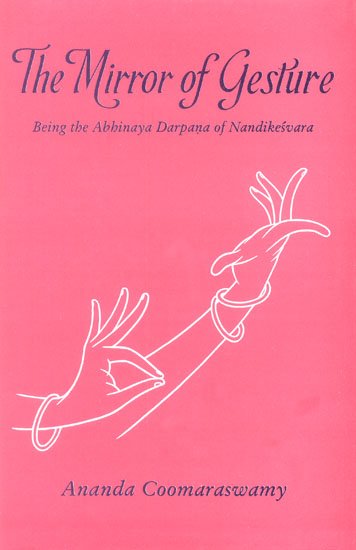Abhinaya-darpana (English)
by Ananda Coomaraswamy | 1917 | 16,981 words | ISBN-13: 9788121500210
The English translation of the Abhinaya-darpana (“the mirror of gesture”) by Nandikeshvara: an encyclopedic manual of the art of gesticulation. It belongs to a wide range of literature known as Natya-shastra: the ancient Indian art of dramatic performance, theatrics, dance and music. The Abhinaya Darpana is an abridgement of the Bharatarnava, a m...
Chapter 8 - Forty-four Glances
The following Glances are mentioned elsewhere:
- Sama,
- Pralokita,
- Snigdha,
- Srṅgara,
- Ullokita,
- Adbhuta,
- Karuṇa,
- Viṣmaya,
- Tṛpta,
- Viṣanna,
- Bhayānaka,
- Sāci,
- Dṛta,
- Vīra,
- Raudra,
- Dūra,
- Iṅgita,
- Vilokita,
- Vitarkita,
- Saṅkita,
- Abhitapta,
- Avalokita,
- Sūnya,
- Hṛṣṭa,
- Ugra,
- Vibhrānta,
- Sānta,
- Mīlita,
- Sūcana,
- Lajjita,
- Malina,
- Trasta,
- Mlāna,
- Mukula,
- Kuñcita,
- Ākāśa,
- Ardhamukula,
- Anuvṛtta,
- Vipluta,
- Jihma,
- Vikośa,
- Madira,
- Hṛdaya,
- Lalita.
Sama: looks like those of the women of the gods (not winking, etc.). Usage: normal circumstances.
Pralokita: casting glances on both sides. Usage: looking on both sides.
Snigdha (tender): the look that is associated with joy, pleasant anticipation, things after one’s own heart, having an inner radiance, expressing the surge of love passion. Usage: in affection.
Sṛṅgāra (love): born of great joy, in the toils of love—raising the eyebrows and looking out of the corners of the eyes. Usage: mutual glances of those who are fast bound by amorous desires.
Vilokita: looking upwards. Usage: tall things, previous births.
Adbhuta: the ends of the eyelids slightly curved, the eyebrows raised in wonder, the eyes shining. Usage: the marvellous.
Karuṇa: a downcast glance, half-vouchsafed, with tears, benevolent, the black pupil slowly moving, regarding the tip of the nose. Usage: the pathetic.
Viṣmaya (astonishment): quickly raised, straight-staring. Usage: astonishment.
Tṛpta (satisfaction): steady, wide-opened, the pupil motionless, keeping its place. Usage: resolution (utsāhd).
Viṣaṇṇa: the eyelids wide apart, eyelashes recurved, the pupil fixed. Usage: dismay, anxiety.
Bhayānaka (inspiring fear): the eyelids raised and fixed, the pupil bright and fluttering. Usage: great fear, the terrible.
Sāci: looking persistently out of the corners of the eye. Usage: secret purpose.
Dṛta (fish?): both pupils moving. Usage: excitement.
Vīra (heroic): radiant, direct, open, rather majestic, self-controlled, the pupils at rest. Usage: the heroic.
Raudra (cruel): unfriendly, red, cruel, the pupils fixed and the lids not moved, the brows contracted and raised. Usage: the cruel.
Dūra (far): slightly raised. Usage: things at a distance.
Iṅgita: sidelong glances expressing joy. Usage: secret thought.
Vilokita: looking back. Usage: things or places behind.
Vitarkita (deliberation): direct, wide-opened, the eyelids separated, the pupils fixed as if in fear. Usage: consideration (ūhā).
Śaṅkita (apprehensive): a little moved, a little at rest, slightly raised and moved to and fro, the pupils partly hidden. Usage: hesitation.
Abhitapta (burnt): the eyelids moving, the pupils gazing languidly. Usage: indifference (i. e. regarding a thing, but without interest).
Avalokita: looking down. Usage: study (paṭhanā), reflection (vicāra).
Śūnya (vacant): eyelids level, pupils visible, motionless, gaze vacant. Usage: misunderstanding (bāhyārtha grahaṇa).
Hṛṣṭa (merry): fluttering, pleasant, twinkling. Usage: laughter.
Ugra (fierce): very wide open, a little red at the corners. Usage: ferocity.
Vibhrānta (wandering): the pupils moving, rolling, unconstrained, between tears and laughter; the wandering glance of excitement.
Śānta (peace): gradually closing the lids, the eyes slightly moving, the pupils moving to the comers; the peaceful glance of dispassion.
Mīlita: nearly closed. Usage: conditions such as subjection to another’s will.
Sūcana: the eyes partly closed, following the movement of the (sūci) hand. Usage: pointing out.
Lajjita: the upper eyelid dropped, the pupil also lowered bashfully, the lashes meeting; this modest glance is used modestly.
Malina: the lashes partly closed as if by rheum, the pupils sunken; this unclean eye denotes women (i. e. dissipation).
Trasta (frightened): inwardly expanded, the pupil raised. Usage: fear and intoxication.
Mima (dull): the pupils moving languidly and slowly, squinting, the lashes seeming to touch; this dull eye indicates insipid matters.
Mukula: the lashes trembling and touching, the expression of the pupils mild, the upper lids lowered; this 'bud’ eye indicates bliss (ānanda).
Kuñcita (curved): the lashes a little recurved, the eyeballs a little sunk; dislike, or jealousy.
Ākāśa (sky): directed towards the sky, the pupil turned far back; indicating things moving above.
Ardhamukula: smiling, the pupils just visible under the lids; this ‘half-bud’ eye indicates bliss and rejoicing.
Anuvṛtta (following): repeated glancing; it is used in hurry.
Vipluta: the lids trembling, expanded, and then dropped; this ‘disordered’ eye indicates beauty in things of all sorts.
Jihma (oblique): bent back, a slow and hidden glance; used to convey secret meanings, and in envy.
Vikośa: without winking, the pupils moving, the lids wide apart; it is used in joy.
Madira: indirect, ranging, centred, unsteady, crooked; it is used to indicate the early stage of intoxication.
Hṛdaya: unsteady, flurried, the pupils moving somewhat (anaglulita), the lids recurved; it is used for mediocre things.
Lolita (graceful): the comers of the eyes closed by the movement of the brows, smiling because of the working of Love, direct; it is used in graceful posing (lalita), etc.
